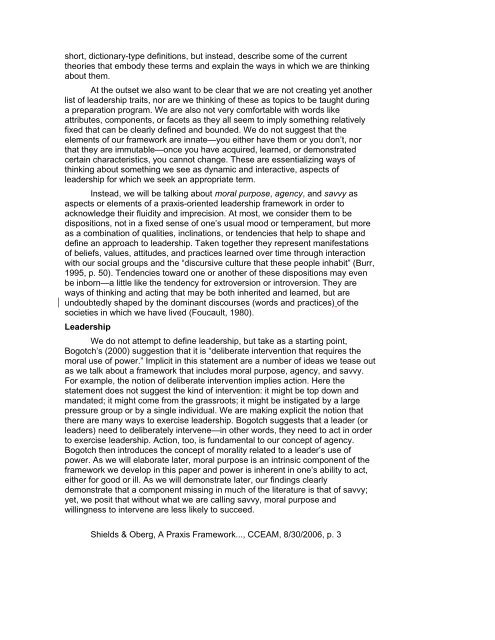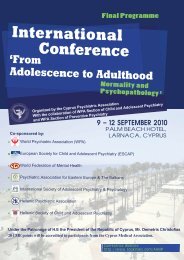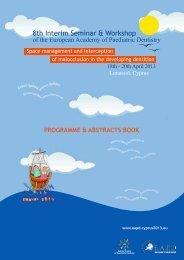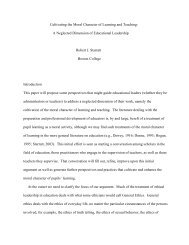SHIELDS M. Carolyn3.pdf
SHIELDS M. Carolyn3.pdf
SHIELDS M. Carolyn3.pdf
You also want an ePaper? Increase the reach of your titles
YUMPU automatically turns print PDFs into web optimized ePapers that Google loves.
short, dictionary-type definitions, but instead, describe some of the current<br />
theories that embody these terms and explain the ways in which we are thinking<br />
about them.<br />
At the outset we also want to be clear that we are not creating yet another<br />
list of leadership traits, nor are we thinking of these as topics to be taught during<br />
a preparation program. We are also not very comfortable with words like<br />
attributes, components, or facets as they all seem to imply something relatively<br />
fixed that can be clearly defined and bounded. We do not suggest that the<br />
elements of our framework are innate—you either have them or you don’t, nor<br />
that they are immutable—once you have acquired, learned, or demonstrated<br />
certain characteristics, you cannot change. These are essentializing ways of<br />
thinking about something we see as dynamic and interactive, aspects of<br />
leadership for which we seek an appropriate term.<br />
Instead, we will be talking about moral purpose, agency, and savvy as<br />
aspects or elements of a praxis-oriented leadership framework in order to<br />
acknowledge their fluidity and imprecision. At most, we consider them to be<br />
dispositions, not in a fixed sense of one’s usual mood or temperament, but more<br />
as a combination of qualities, inclinations, or tendencies that help to shape and<br />
define an approach to leadership. Taken together they represent manifestations<br />
of beliefs, values, attitudes, and practices learned over time through interaction<br />
with our social groups and the “discursive culture that these people inhabit” (Burr,<br />
1995, p. 50). Tendencies toward one or another of these dispositions may even<br />
be inborn—a little like the tendency for extroversion or introversion. They are<br />
ways of thinking and acting that may be both inherited and learned, but are<br />
undoubtedly shaped by the dominant discourses (words and practices) of the<br />
societies in which we have lived (Foucault, 1980).<br />
Leadership<br />
We do not attempt to define leadership, but take as a starting point,<br />
Bogotch’s (2000) suggestion that it is “deliberate intervention that requires the<br />
moral use of power.” Implicit in this statement are a number of ideas we tease out<br />
as we talk about a framework that includes moral purpose, agency, and savvy.<br />
For example, the notion of deliberate intervention implies action. Here the<br />
statement does not suggest the kind of intervention: it might be top down and<br />
mandated; it might come from the grassroots; it might be instigated by a large<br />
pressure group or by a single individual. We are making explicit the notion that<br />
there are many ways to exercise leadership. Bogotch suggests that a leader (or<br />
leaders) need to deliberately intervene—in other words, they need to act in order<br />
to exercise leadership. Action, too, is fundamental to our concept of agency.<br />
Bogotch then introduces the concept of morality related to a leader’s use of<br />
power. As we will elaborate later, moral purpose is an intrinsic component of the<br />
framework we develop in this paper and power is inherent in one’s ability to act,<br />
either for good or ill. As we will demonstrate later, our findings clearly<br />
demonstrate that a component missing in much of the literature is that of savvy;<br />
yet, we posit that without what we are calling savvy, moral purpose and<br />
willingness to intervene are less likely to succeed.<br />
Shields & Oberg, A Praxis Framework..., CCEAM, 8/30/2006, p. 3














